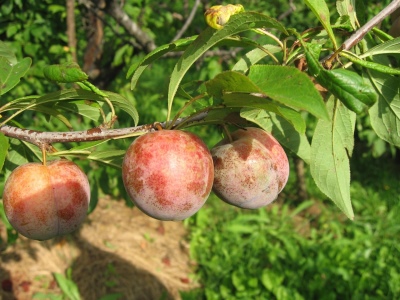
- Growth type: medium-sized
- Crown: spherical, medium density
- Tree height, m: up to 2.5
- Fruit size: large
- Fruit weight, g: 20-30
- Fruit shape: rounded
- Fruit color: dark crimson
- Skin : thin
- Pulp (consistency): juicy
- Pulp color : dark crimson
Among the many types of plum trees, there is a whole list of favorite varieties that summer residents are happy to plant on the plots. These include Krasnomyasaya of Russian selection, with a wide geography of growth.
Breeding history
Dessert plum is obtained thanks to the work of breeders of the N.I. Lisavenko in Altai. A variety was bred by crossing two species - Chinese plum and cherry plum. This variety has 12 subspecies. The fruit tree is recommended for cultivation both in the southern and northern regions, including Siberia and the Urals.
Description of the variety
Plum Krasnomyasaya is a medium-sized tree with a neat spherical crown. The tree grows up to 2.5 m in height, sometimes up to 3. It is characterized by a tree of medium thickening with light green leaves, strong branches and a powerful trunk of gray-brown color with a smooth surface. The plum begins to bloom from the end of April, and the process continues until the first decade of June. During this period, the openwork crown of the tree is covered with small white-pink flowers with five petals, emitting a pleasant aroma.
Fruit characteristics
The variety represents the category of large-fruited species of the almond family. Fruit weight ranges from 20 to 30 grams. Ripe plum is evenly covered with dark crimson color, attracting attention. The shape of the fruit is correct, round, sometimes slightly elongated. The plum peel is smooth and thin with a glossy surface. The stone inside the fruit is oval in shape, easily separating from the pulp.
Plums are characterized by good transport tolerance, as well as sufficient keeping quality. The purpose of the variety is dessert - plums are eaten fresh, processed into compotes, jams, and used in cooking.
Taste qualities
Plum stands out for its excellent taste and marketability. The dark raspberry pulp has a tender, fleshy and dense texture with increased juiciness. The fruit has a balanced taste - sweet and sour, complemented by a bright plum aroma. Sometimes a slight bitterness can be traced in the peel with a sour taste.
Ripening and fruiting
The variety belongs to the class of crops with medium ripening periods. The tree begins to bear fruit in the 3rd year after planting. The tasting period starts in mid-August. The culture bears fruit stably and annually, without gaps. The active phase of fruit ripening occurs in the 2-3rd decade of August. Sometimes the timing of fruiting can be shifted. This is due to the climatic features of the growing region.

Yield
The yield indicators of the variety are good. Providing the tree with proper care, it is possible to collect up to 20 kg of sweet plums from it per season.
Growing regions
Red meat plum is very popular among gardeners, therefore it is grown in different regions. The plum variety is popular in Eastern Europe, North America, China and, of course, Russia.It is characteristic that due to frost resistance and quick adaptation to the climate, the variety is productive both in the southern strip and in the north.
Self-fertility and the need for pollinators
Plum Krasnomyasaya is self-fertile, so you can't do without planting donor trees on the site. Pollinating trees should bloom at the same time period as this variety. The best donors are: Ussuriiskaya, hybrid cherry plum, Skoroplodnaya, Russian plum. It is important to remember that the distance between different plum trees should be about 10 meters.
Growing and care
The variety has no special requirements for agricultural technology, however, the plum is a little whimsical to the site and soils. You should choose an area well-lit by the sun, which is reliably protected from drafts and gusty winds. Fertile sandy loam soil or loam with a neutral acidity level is considered ideal.
Care includes: watering, fertilizing, crown formation, sanitary pruning of branches, measures to protect against viruses and insects. In addition, mulching using peat or sawdust is mandatory in the fall.
Planting a seedling is carried out in the spring (late March - early May) or autumn (a month before stable frosts).




Disease and pest resistance
Due to its strong immunity, the fruit crop is resistant to most diseases and pests characteristic of plums. The tree easily repels the attacks of aphids, does not undergo gum flow, and also perfectly resists the main enemy - clasterosporium.

Despite the fact that plum is considered more hardy than many fruit trees, it is not immune from diseases. It is attacked by viral, fungal and bacterial infections, and parasitic insects harm it. It is necessary to notice and recognize the signs of plum disease in time. They are easier to deal with and defeat early on. Well, in order to protect the garden tree from such a misfortune in the future, preventive procedures can be carried out.
Resistance to soil and climatic conditions
The resistance to stress of the fruit tree is one of its advantages. The culture is characterized by frost resistance, drought resistance, excellent adaptability to the climatic features of the region where it grows. Does not tolerate a tree of deep shade and drafts.



































































